Mafic Enclaves Reveal Multi-Magma Storage and Feeding of Shangri-La Lavas at the Nevados de Chillán Volcanic Complex
Abstract
1. Introduction
2. Geological Setting
3. Sampling and Analytical Methods
4. Results
4.1. Whole Rock Composition
4.2. Petrography
4.3. Mineral Chemistry
4.4. Intensive Parameters
| Unit | Phases | Intensive Condition | Reference | Average | Range | Standard Deviation | Uncertainty |
|---|---|---|---|---|---|---|---|
| Dacite (host lava) | Fe-Ti ox | Temperature (°C) | [53] | 950 | 891–981 | 23 | 8 |
| Oxygen fugacity (Δ NNO) | −0.1 | −0.3–0.2 | 0.2 | 0.1 | |||
| Dacite (host lava) | Cpx | Pressure (kbar) | [54] | 1.5 | 0.1–2.2 | 0.6 | 1.8 |
| Temperature (°C) | 1051 | 1031–1094 | 20 | 37 | |||
| Enclave | Cpx | Pressure (kbar) | [54] | 2.2 | 0.5–5.9 | 1.2 | 1.7 |
| Temperature (°C) | 1085 | 1049–1131 | 24 | 37 | |||
| Enclave | Two Px | Temperature (°C) | [56] | 982 | 972–991 | 10 | 60 |
| Pressure (kbar) | [56] | 3.1 | 1.3–4.2 | 1.6 | 3.21 |
5. Discussion
5.1. Textural Evidence of Magma Mixing
5.2. Modeling Constraints
5.3. Magmatic Evolution of the NChVC
5.4. Potential Tectonic Control on the Magma Plumbing System
6. Conclusions
- (1)
- Irregular boundaries between enclaves which exhibit lower crystallinity suggestive of partial melting;
- (2)
- The presence of olivine and high-An70 plagioclase phenocrysts which are in clear disequilibrium with the host lavas and that can be chemically and texturally associated with the enclaves;
- (3)
- The presence of plagioclase with disequilibrium textures and lower An40 content that can be related chemically with phenocrysts from the dacite host lava.
Supplementary Materials
Author Contributions
Funding
Data Availability Statement
Acknowledgments
Conflicts of Interest
References
- Cioni, R.; Bertagnini, A.; Santacroce, R.; Andronico, D. Explosive Activity and Eruption Scenarios at Somma-Vesuvius (Italy): Towards a New Classification Scheme. J. Volcanol. Geotherm. Res. 2008, 178, 331–346. [Google Scholar] [CrossRef]
- Cassidy, M.; Manga, M.; Cashman, K.; Bachmann, O. Controls on Explosive-Effusive Volcanic Eruption Styles. Nat. Commun. 2018, 9, 2839. [Google Scholar] [CrossRef]
- Castro, J.M.; Cordonnier, B.; Tuffen, H.; Tobin, M.J.; Puskar, L.; Martin, M.C.; Bechtel, H.A. The Role of Melt-Fracture Degassing in Defusing Explosive Rhyolite Eruptions at Volcán Chaitén. Earth Planet. Sci. Lett. 2012, 333–334, 63–69. [Google Scholar] [CrossRef]
- Morgavi, D.; Laumonier, M.; Petrelli, M.; Dingwell, D.B. Decrypting Magma Mixing in Igneous Systems. Rev. Miner. Geochem. 2022, 87, 607–638. [Google Scholar] [CrossRef]
- Bachmann, O. The Petrologic Evolution and Pre-Eruptive Conditions of the Rhyolitic Kos Plateau Tuff (Aegean Arc). Cent. Eur. J. Geosci. 2010, 2, 270–305. [Google Scholar] [CrossRef][Green Version]
- Ruprecht, P.; Bachmann, O. Pre-Eruptive Reheating during Magma Mixing at Quizapu Volcano and the Implications for the Explosiveness of Silicic Arc Volcanoes. Geology 2010, 38, 919–922. [Google Scholar] [CrossRef]
- Kress, V. Magma Mixing as a Source for Pinatubo Sulphur. Nature 1997, 389, 591–593. [Google Scholar] [CrossRef]
- Morgavi, D.; Arzilli, F.; Pritchard, C.; Perugini, D.; Mancini, L.; Larson, P.; Dingwell, D.B. The Grizzly Lake Complex (Yellowstone Volcano, USA): Mixing between Basalt and Rhyolite Unraveled by Microanalysis and X-Ray Microtomography. Lithos 2016, 260, 457–474. [Google Scholar] [CrossRef]
- Self, S. Krakatau Revisited: The Course of Events and Interpretation of the 1883 Eruption. GeoJournal 1992, 28, 109–121. [Google Scholar] [CrossRef]
- Eichelberger, J.C. Origin of Andesite and Dacite: Evidence of Mixing at Glass Mountain in California and at Other Circum-Pacific Volcanoes. GSA Bull. 1975, 86, 1381–1391. [Google Scholar] [CrossRef]
- Feeley, T.C.; Dungan, M.A. Compositional and Dynamic Controls on Mafic-Silicic Magma Interactions at Continental Arc Volcanoes: Evidence from Cordón El Guadal, Tatara-San Pedro Complex, Chile. J. Petrol. 1996, 37, 1547–1577. [Google Scholar] [CrossRef]
- Kratzmann, D.J.; Carey, S.; Scasso, R.; Naranjo, J.A. Compositional Variations and Magma Mixing in the 1991 Eruptions of Hudson Volcano, Chile. Bull. Volcanol. 2009, 71, 419–439. [Google Scholar] [CrossRef]
- Tepley Iii, F.J.; Davidson, J.P.; Tilling, R.I.; Arth, J.G. Magma Mixing, Recharge and Eruption Histories Recorded in Plagioclase Phenocrysts from El Chichón Volcano, Mexico. J. Petrol. 2000, 41, 1397–1411. [Google Scholar] [CrossRef]
- Bacon, C.R. Magmatic Inclusions in Silicic and Intermediate Volcanic Rocks. J. Geophys. Res. Solid Earth 1986, 91, 6091–6112. [Google Scholar] [CrossRef]
- Plail, M.; Edmonds, M.; Woods, A.W.; Barclay, J.; Humphreys, M.C.S.; Herd, R.A.; Christopher, T. Mafic Enclaves Record Syn-Eruptive Basalt Intrusion and Mixing. Earth Planet. Sci. Lett. 2018, 484, 30–40. [Google Scholar] [CrossRef]
- Murphy, M.D.; Sparks, R.S.J.; Barclay, J.; Carroll, M.R.; Brewer, T.S. Remobilization of Andesite Magma by Intrusion of Mafic Magma at the Soufriere Hills Volcano, Montserrat, West Indies. J. Petrol. 2000, 41, 21–42. [Google Scholar] [CrossRef]
- Ruprecht, P.; Bergantz, G.W.; Cooper, K.M.; Hildreth, W. The Crustal Magma Storage System of Volcán Quizapu, Chile, and the Effects of Magma Mixing on Magma Diversity. J. Petrol. 2012, 53, 801–840. [Google Scholar] [CrossRef]
- Winslow, H.; Ruprecht, P.; Gonnermann, H.M.; Phelps, P.R.; Muñoz-Saez, C.; Delgado, F.; Pritchard, M.; Amigo, A. Insights for Crystal Mush Storage Utilizing Mafic Enclaves from the 2011–12 Cordón Caulle Eruption. Sci. Rep. 2022, 12, 9737. [Google Scholar] [CrossRef]
- Ruprecht, P.; Simon, A.C.; Fiege, A. The Survival of Mafic Magmatic Enclaves and the Timing of Magma Recharge. Geophys. Res. Lett. 2020, 47, e2020GL087186. [Google Scholar] [CrossRef]
- Holness, M.B.; Stock, M.J.; Geist, D. Magma Chambers versus Mush Zones: Constraining the Architecture of Sub-Volcanic Plumbing Systems from Microstructural Analysis of Crystalline Enclaves. Philos. Trans. R. Soc. A Math. Phys. Eng. Sci. 2019, 377, 20180006. [Google Scholar] [CrossRef]
- Andrews, B.J.; Manga, M. Thermal and Rheological Controls on the Formation of Mafic Enclaves or Banded Pumice. Contrib. Mineral. Petrol. 2014, 167, 961. [Google Scholar] [CrossRef]
- Martel, C.; Ali, A.R.; Poussineau, S.; Gourgaud, A.; Pichavant, M. Basalt-Inherited Microlites in Silicic Magmas: Evidence from Mount Pelée (Martinique, French West Indies). Geology 2006, 34, 905–908. [Google Scholar] [CrossRef]
- Humphreys, M.C.S.; Blundy, J.D.; Sparks, R.S.J. Magma Evolution and Open-System Processes at Shiveluch Volcano: Insights from Phenocryst Zoning. J. Petrol. 2006, 47, 2303–2334. [Google Scholar] [CrossRef]
- Ginibre, C.; Wörner, G.; Kronz, A. Crystal Zoning as an Archive for Magma Evolution. Elements 2007, 3, 261–266. [Google Scholar] [CrossRef]
- Cashman, K.; Blundy, J. Petrological Cannibalism: The Chemical and Textural Consequences of Incremental Magma Body Growth. Contrib. Mineral. Petrol. 2013, 166, 703–729. [Google Scholar] [CrossRef]
- Gudmundsson, A. Magma Chambers: Formation, Local Stresses, Excess Pressures, and Compartments. J. Volcanol. Geotherm. Res. 2012, 237–238, 19–41. [Google Scholar] [CrossRef]
- Annen, C.; Blundy, J.D.; Sparks, R.S.J. The Genesis of Intermediate and Silicic Magmas in Deep Crustal Hot Zones. J. Petrol. 2006, 47, 505–539. [Google Scholar] [CrossRef]
- Annen, C.; Sparks, R.S.J. Effects of Repetitive Emplacement of Basaltic Intrusions on Thermal Evolution and Melt Generation in the Crust. Earth Planet. Sci. Lett. 2002, 203, 937–955. [Google Scholar] [CrossRef]
- Sparks, R.S.J.; Annen, C.; Blundy, J.D.; Cashman, K.V.; Rust, A.C.; Jackson, M.D. Formation and Dynamics of Magma Reservoirs. Philos. Trans. R. Soc. A Math. Phys. Eng. Sci. 2019, 377, 20180019. [Google Scholar] [CrossRef]
- Watanabe, T.; Koyaguchi, T.; Seno, T. Tectonic Stress Controls on Ascent and Emplacement of Magmas. J. Volcanol. Geotherm. Res. 1999, 91, 65–78. [Google Scholar] [CrossRef]
- Hughes, G.R.; Mahood, G.A. Silicic Calderas in Arc Settings: Characteristics, Distribution, and Tectonic Controls. Bull. Geol. Soc. Am. 2011, 123, 1577–1595. [Google Scholar] [CrossRef]
- Cembrano, J.; Lara, L. The Link between Volcanism and Tectonics in the Southern Volcanic Zone of the Chilean Andes: A Review. Tectonophysics 2009, 471, 96–113. [Google Scholar] [CrossRef]
- Biggs, J.; Annen, C. The Lateral Growth and Coalesence of Magma Systems. Philos. Trans. R. Soc. A Math. Phys. Eng. Sci. 2019, 377, 20180005. [Google Scholar] [CrossRef]
- Nakamura, K. Volcanoes as Possible Indicators of Tectonic Stress Orientation—Principle and Proposal. J. Volcanol. Geotherm. Res. 1977, 2, 1–16. [Google Scholar] [CrossRef]
- Lupi, M.; Trippanera, D.; Gonzalez, D.; Sebastiano, D.; Acocella, V.; Cabello, C.; Muelle, M.; Tassara, A. Tectonophysics Transient Tectonic Regimes Imposed by Megathrust Earthquakes and the Growth of NW-Trending Volcanic Systems in the Southern Andes. Tectonophysics 2020, 774, 228204. [Google Scholar] [CrossRef]
- Espinosa-Leal, J.; Browning, J.; Cembrano, J.; Mitchell, T.; Rojas, F.; Moorkamp, M.; Griffith, W.A.; Meredith, P. Fault Intersection-Related Stress Rotation Controls Magma Emplacement at the Nevados de Chillán Volcanic Complex. J. Volcanol. Geotherm. Res. 2025, 458, 108255. [Google Scholar] [CrossRef]
- Astort, A.; Boixart, G.; Folguera, A.; Battaglia, M. Volcanic Unrest at Nevados de Chillán (South Andean Volcanic Zone) from January 2019 to November 2020, Imaged by DInSAR. J. Volcanol. Geotherm. Res. 2022, 427, 107568. [Google Scholar] [CrossRef]
- Cardona, C.; Gil-Cruz, F.; Franco-Marín, L.; San Martín, J.; Valderrama, O.; Lazo, J.; Cartes, C.; Morales, S.; Hernández, E.; Quijada, J.; et al. Volcanic Activity Accompanying the Emplacement of Dacitic Lava Domes and Effusion of Lava Flows at Nevados de Chillán Volcanic Complex—Chilean Andes (2012 to 2020). J. Volcanol. Geotherm. Res. 2021, 420, 107409. [Google Scholar] [CrossRef]
- Naranjo, J.A.; Gilbert, J.; Sparks, R.S. Geología del Complejo Volcánico Nevados de Chillán, Región Del Biobío; SERNAGEOMIN: Santiago, Chile, 2008. [Google Scholar]
- Rojas, F.; Browning, J.; Tuffen, H.; Cembrano, J.; Espinosa-Leal, J.; Unwin, H.E.; Mitchell, T.M.; Hofer-Apostolidis, K.; Meredith, P.G. Textural Evidence of Fragmentation and Densification Processes in a Fossilised Shallow Conduit on the Flank of Nevados de Chillán Volcanic Complex. J. Volcanol. Geotherm. Res. 2024, 447, 108028. [Google Scholar] [CrossRef]
- Mura, V.; Arancibia, G.; Browning, J.; Healy, D.; López-Contreras, C.; Morata, D.; Maza, S.; Cardona, C. Structural Control on the Southern Andean Nevados de Chillán Geothermal System. J. Struct. Geol. 2025, 196. [Google Scholar] [CrossRef]
- Mee, K.; Tuffen, H.; Gilbert, J.S. Snow-Contact Volcanic Facies and Their Use in Determining Past Eruptive Environments at Nevados de Chillán Volcano, Chile. Bull. Volcanol. 2006, 68, 363–376. [Google Scholar] [CrossRef]
- Mee, K.; Gilbert, J.S.; McGarvie, D.W.; Naranjo, J.A.; Pringle, M.S. Palaeoenvironment Reconstruction, Volcanic Evolution and Geochronology of the Cerro Blanco Subcomplex, Nevados de Chillán Volcanic Complex, Central Chile. Bull. Volcanol. 2009, 71, 933–952. [Google Scholar] [CrossRef]
- Dixon, H.J.; Murphy, M.D.; Sparks, S.J.; Chávez, R.; Naranjo, J.A.; Dunkley, P.N.; Young, S.R.; Gilbert, J.S.; Pringle, M.S. The Geology of Nevados de Chillan Volcano, Chile. Rev. Geol. Chile 1999, 26, 227–253. [Google Scholar] [CrossRef]
- Murphy, M.D. The Geology and Geochemistry of Nevados de Chillán Volcano; ChileBritish Geological Survey: Nottingham, UK, 1995. [Google Scholar]
- Radic, J.P. Andean Geology Formerly Revista Geológica de Chile Las Cuencas Cenozoicas y Su Control En El Volcanismo de Los Complejos Nevados de Chillán y Copahue-Callaqui (Andes Del Sur, 36–39°S). Andean Geol. 2010, 37, 220–246. [Google Scholar]
- González-Vidal, D.; Obermann, A.; Tassara, A.; Bataille, K.; Lupi, M. Crustal Model of the Southern Central Andes Derived from Ambient Seismic Noise Rayleigh-Wave Tomography. Tectonophysics 2018, 744, 215–226. [Google Scholar] [CrossRef]
- Novoa Lizama, C.; Remy, D.; Baez, J.C.; Oyarzun, A.; Bonvalot, S.; Hooper, A. Modeling Magma Recharge Dynamics during the 2016 Nevados de Chillan Eruption: An Interacting Two-Chamber System Evidenced by Petrology and Geodesy. J. Volcanol. Geotherm. Res. 2025, 458, 108253. [Google Scholar] [CrossRef]
- Oyarzún, A.; Lara, L.E.; Tassara, A. Decoding the Plumbing System of Nevados de Chillán Volcanic Complex, Southern Andes. J. Volcanol. Geotherm. Res. 2022, 422, 107455. [Google Scholar] [CrossRef]
- Zellmer, G.F. Gaining Acuity on Crystal Terminology in Volcanic Rocks. Bull. Volcanol. 2021, 83, 78. [Google Scholar] [CrossRef]
- Le Bas, M.J.L.; Maitre, R.W.L.; Streckeisen, A.; Zanettin, B. A Chemical Classification of Volcanic Rocks Based on the Total Alkali-Silica Diagram. J. Petrol. 1986, 27, 745–750. [Google Scholar] [CrossRef]
- Bacon, C.R.; Hirschmann, M.M. Mg/Mn Partitioning as a Test for Equilibrium between Coexisting Fe-Ti Oxides. Am. Mineral. 1988, 73, 57–61. [Google Scholar]
- Ghiorso, M.S.; Evans, B.W. Thermodynamics of Rhombohedral Oxide Solid Solutions and a Revision of the Fe-Ti Two-Oxide Geothermometer and Oxygen-Barometer. Am. J. Sci. 2008, 308, 957–1039. [Google Scholar] [CrossRef]
- Wang, X.; Hou, T.; Wang, M.; Zhang, C.; Zhang, Z.; Pan, R.; Marxer, F.; Zhang, H. A New Clinopyroxene Thermobarometer for Mafic to Intermediate Magmatic Systems. Eur. J. Mineral. 2021, 33, 621–637. [Google Scholar] [CrossRef]
- Waters, L.E.; Lange, R.A. An Updated Calibration of the Plagioclase-Liquid Hygrometer-Thermometer Applicable to Basalts through Rhyolites. Am. Mineral. 2015, 100, 2172–2184. [Google Scholar] [CrossRef]
- Putirka, K.D. Thermometers and Barometers for Volcanic Systems. Rev. Miner. Geochem. 2008, 69, 61–120. [Google Scholar] [CrossRef]
- Clynne, M.A. A Complex Magma Mixing Origin for Rocks Erupted in 1915, Lassen Peak, California. J. Petrol. 1999, 40, 105–132. [Google Scholar] [CrossRef]
- Coombs, M.L.; Gardner, J.E. Reaction Rim Growth on Olivine in Silicic Melts: Implications for Magma Mixing. Am. Mineral. 2004, 89, 748–758. [Google Scholar] [CrossRef]
- Beard, J.S.; Ragland, P.C.; Crawford, M.L. Reactive Bulk Assimilation: A Model for Crust-Mantle Mixing in Silicic Magmas. Geology 2005, 33, 681–684. [Google Scholar] [CrossRef]
- Humphreys, M.C.S.; Christopher, T.; Hards, V. Microlite Transfer by Disaggregation of Mafic Inclusions Following Magma Mixing at Soufrière Hills Volcano, Montserrat. Contrib. Mineral. Petrol. 2009, 157, 609–624. [Google Scholar] [CrossRef]
- Viccaro, M.; Giacomoni, P.P.; Ferlito, C.; Cristofolini, R. Dynamics of Magma Supply at Mt. Etna Volcano (Southern Italy) as Revealed by Textural and Compositional Features of Plagioclase Phenocrysts. Lithos 2010, 116, 77–91. [Google Scholar] [CrossRef]
- Renjith, M.L. Micro-Textures in Plagioclase from 1994-1995 Eruption, Barren Island Volcano: Evidence of Dynamic Magma Plumbing System in the Andaman Subduction Zone. Geosci. Front. 2014, 5, 113–126. [Google Scholar] [CrossRef]
- Nelson, S.; Montana, A. Sieve-Textured Plagioclase in Volcanic Rocks Produced by Rapid Decompression. Am. Mineral. 1992, 77, 1242–1249. [Google Scholar]
- Morgado, E.; Parada, M.A.; Morgan, D.J.; Gutiérrez, F.; Castruccio, A.; Contreras, C. Transient Shallow Reservoirs beneath Small Eruptive Centres: Constraints from Mg-Fe Interdiffusion in Olivine. J. Volcanol. Geotherm. Res. 2017, 347, 327–336. [Google Scholar] [CrossRef]
- Schaaf, P.; Stimac, J.; Siebe, C.; Macías, J.L. Geochemical Evidence for Mantle Origin and Crustal Processes in Volcanic Rocks from Popocatépetl and Surrounding Monogenetic Volcanoes, Central Mexico. J. Petrol. 2005, 46, 1243–1282. [Google Scholar] [CrossRef]
- Zellmer, G.F.; Annen, C.; Charlier, B.L.A.; George, R.M.M.; Turner, S.P.; Hawkesworth, C.J. Magma Evolution and Ascent at Volcanic Arcs: Constraining Petrogenetic Processes through Rates and Chronologies. J. Volcanol. Geotherm. Res. 2005, 140, 171–191. [Google Scholar] [CrossRef]
- Cashman, K.V.; Sparks, R.S.J.; Blundy, J.D. Vertically Extensive and Unstable Magmatic Systems: A Unified View of Igneous Processes. Science 2017, 355, eaag3055. [Google Scholar] [CrossRef] [PubMed]
- Browning, J.; Tuffen, H.; James, M.R.; Owen, J.; Castro, J.M.; Halliwell, S.; Wehbe, K. Post-Fragmentation Vesiculation Timescales in Hydrous Rhyolitic Bombs from Chaitén Volcano. J. South Am. Earth Sci. 2020, 104, 102807. [Google Scholar] [CrossRef]
- Boudreau, A. Bubble Migration in a Compacting Crystal-Liquid Mush. Contrib. Mineral. Petrol. 2016, 171, 32. [Google Scholar] [CrossRef]
- Lormand, C.; Zellmer, G.F.; Sakamoto, N.; Ubide, T.; Kilgour, G.; Yurimoto, H.; Palmer, A.; Németh, K.; Iizuka, Y.; Moebis, A. Shallow Magmatic Processes Revealed by Cryptic Microantecrysts: A Case Study from the Taupo Volcanic Zone. Contrib. Mineral. Petrol. 2021, 176, 97. [Google Scholar] [CrossRef]
- Clunes, M.; Browning, J.; Cembrano, J.; Marquardt, C.; Gudmundsson, A. Crustal Folds Alter Local Stress Fields as Demonstrated by Magma Sheet—Fold Interactions in the Central Andes. Earth Planet. Sci. Lett. 2021, 570, 117080. [Google Scholar] [CrossRef]
- Drymoni, K.; Browning, J.; Gudmundsson, A. Volcanotectonic Interactions between Inclined Sheets, Dykes, and Faults at the Santorini Volcano, Greece. J. Volcanol. Geotherm. Res. 2021, 416, 107294. [Google Scholar] [CrossRef]
- Pérez-Estay, N.; Ruz-Ginouves, J.; Pérez-Flores, P.; Sielfeld, G.; Roquer, T.; Cembrano, J. Decoding the State of Stress and Fluid Pathways along the Andean Southern Volcanic Zone. Commun. Earth Environ. 2023, 4, 390. [Google Scholar] [CrossRef]
- Piquer, J.; Skarmeta, J.; Cooke, D.R. Structural Evolution of the Rio Blanco-Los Bronces District, Andes of Central Chile: Controls on Stratigraphy, Magmatism, and Mineralization. Econ. Geol. 2015, 110, 1995–2023. [Google Scholar] [CrossRef]
- Salas, P.A.; Rabbia, O.M.; Hernández, L.B.; Ruprecht, P. Mafic Monogenetic Vents at the Descabezado Grande Volcanic Field (35.5°S–70.8°W): The Northernmost Evidence of Regional Primitive Volcanism in the Southern Volcanic Zone of Chile. Int. J. Earth Sci. 2017, 106, 1107–1121. [Google Scholar] [CrossRef]


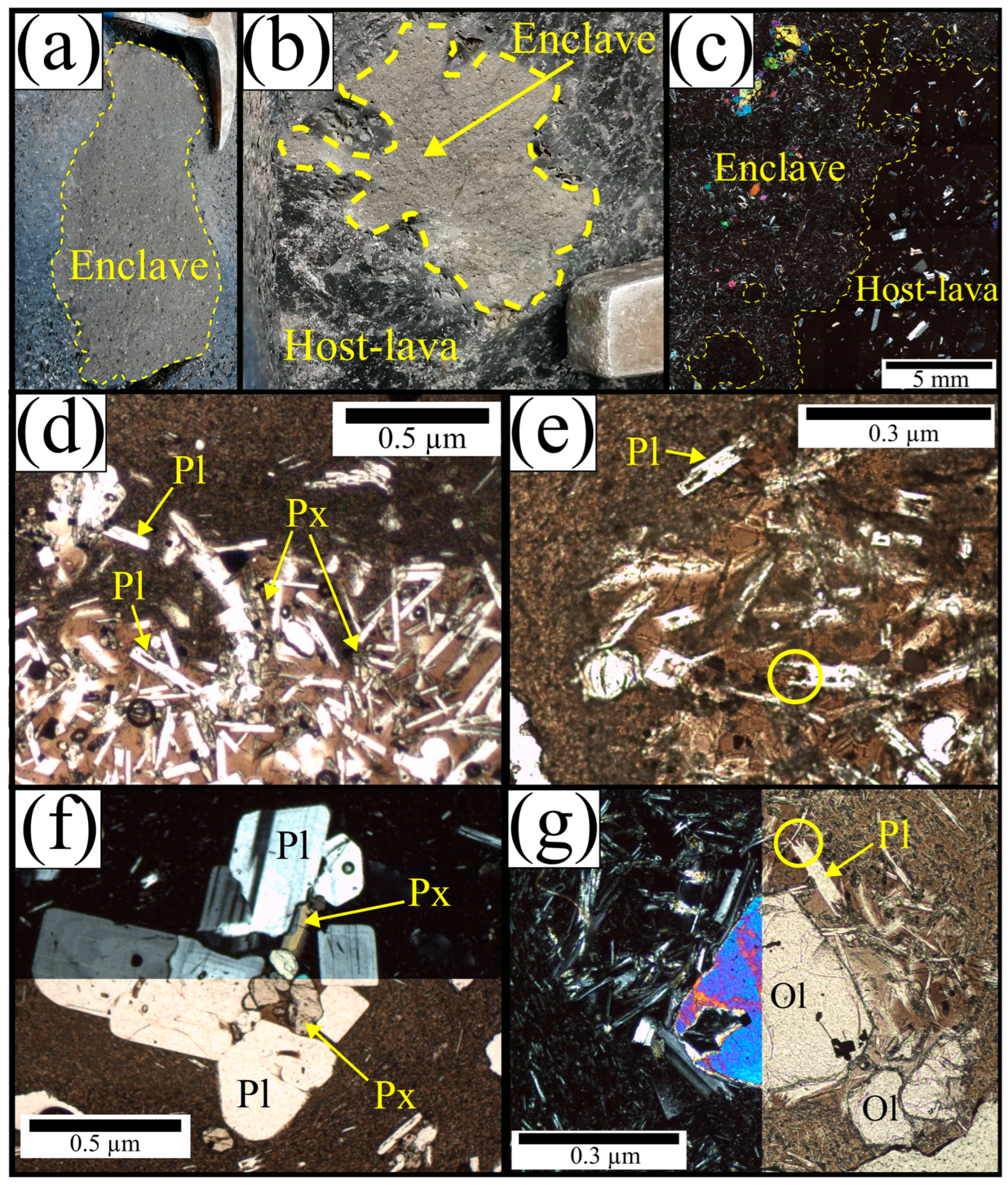
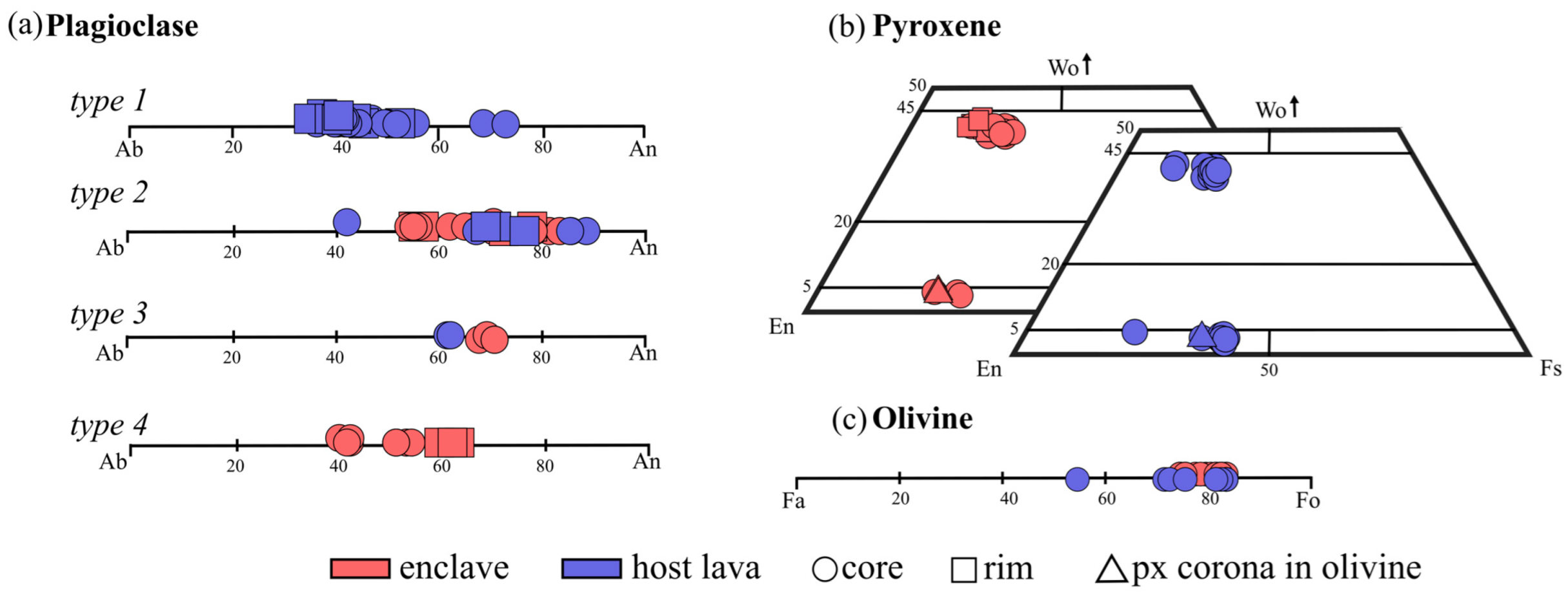
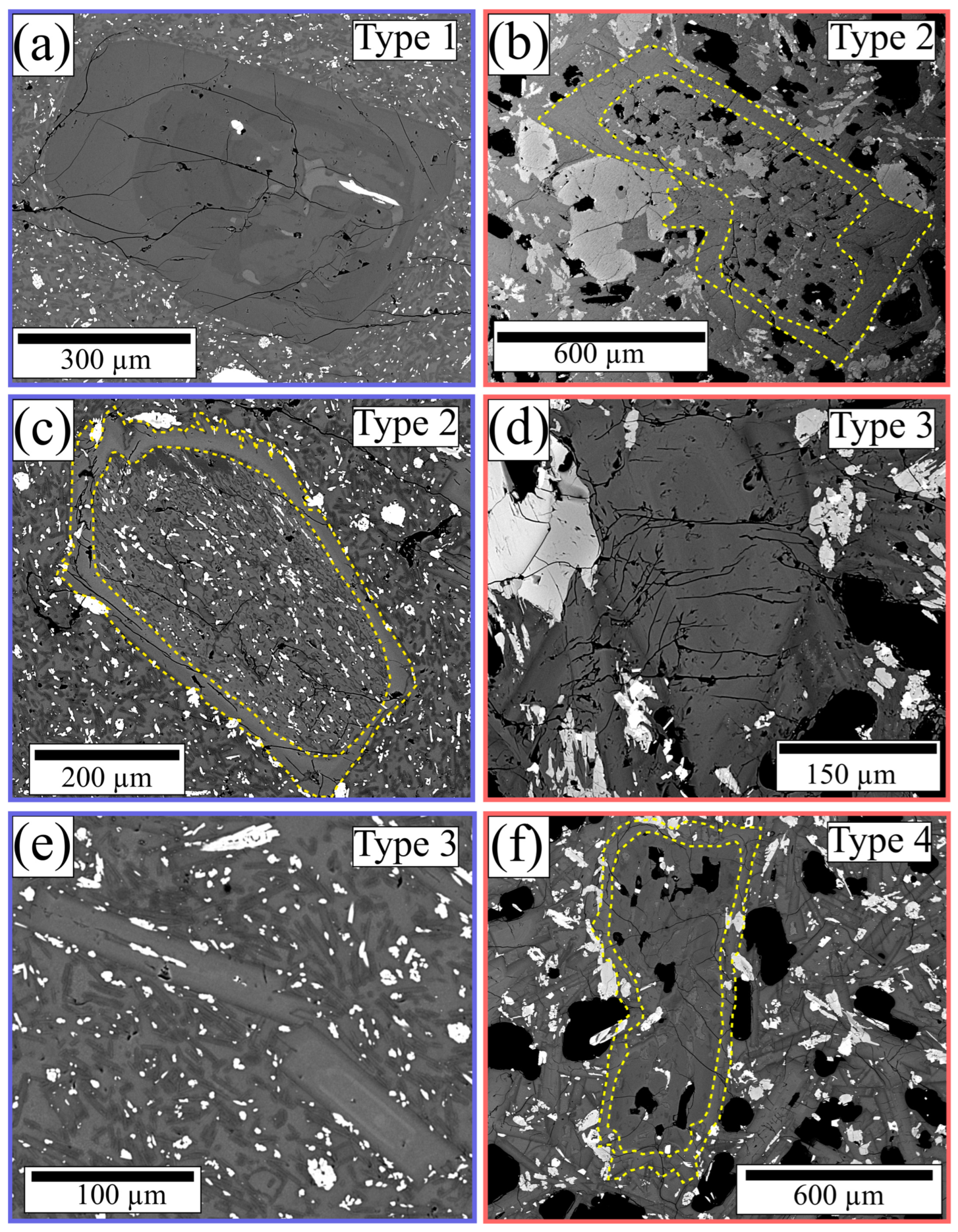
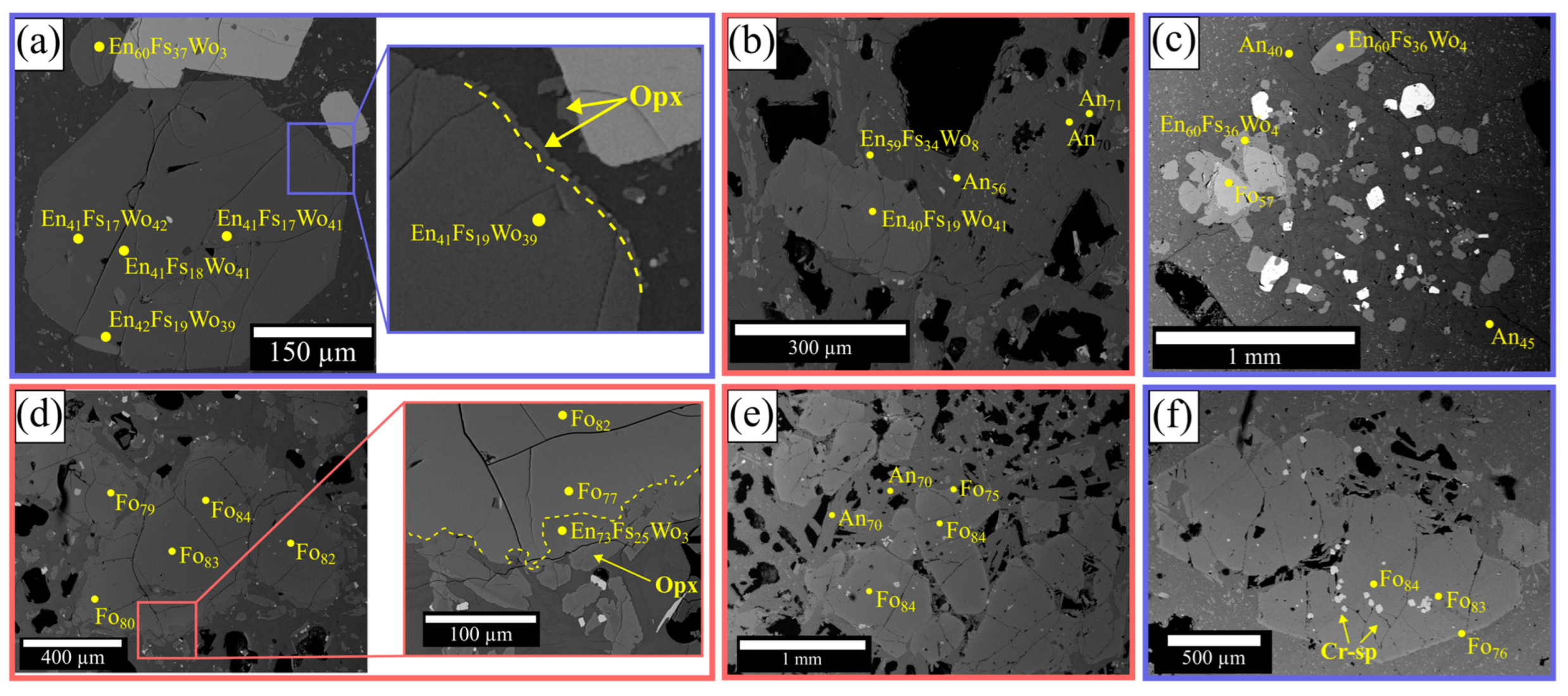


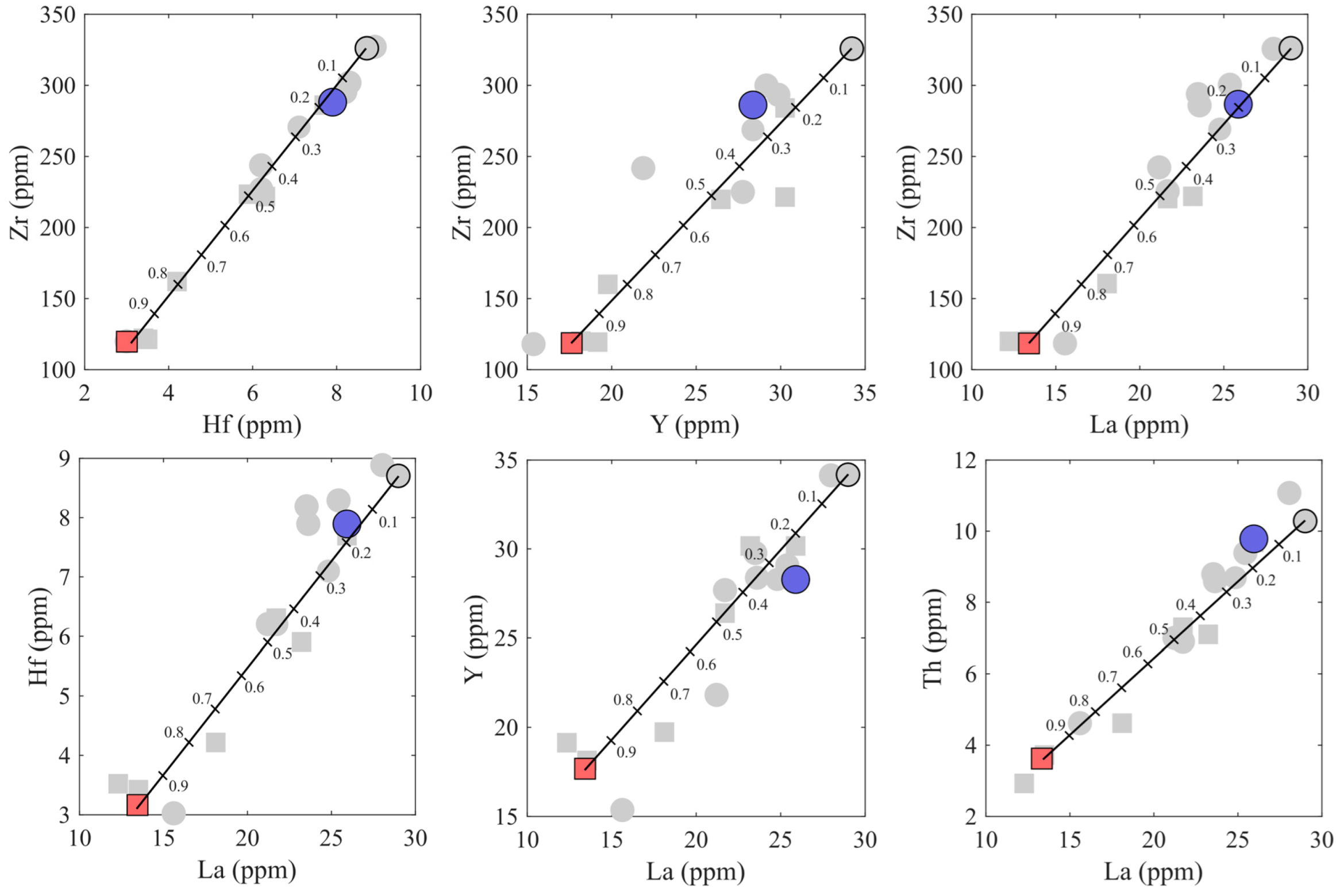
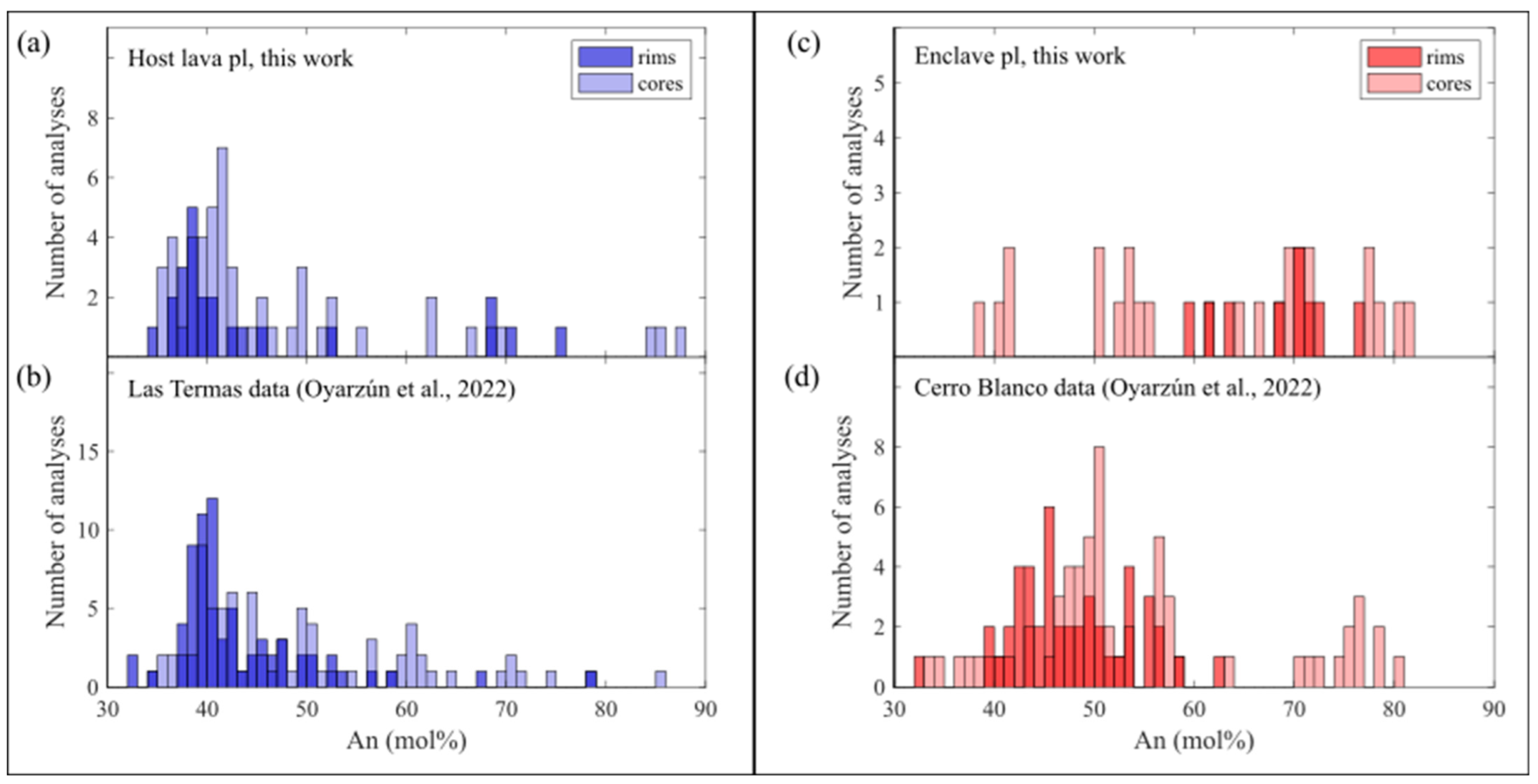
| Type | Texture | Composition | Location |
|---|---|---|---|
| 1 | Euhedral with occasional resorption in core and mantle | Cores of An40–50, (rarely An70), oscillatory, rims An40 | Host lavas |
| 2 | Euhedral to subhedral with fine sieve in core and mantle | Cores of An>60, overgrowth rim of An70–77. When in enclaves, show a very thin rim of An55 | Host lavas/enclaves |
| 3 | Subhedral to euhedral with no disequilibrium textures | An60–70 with a very thin rim when in host lavas An40 | Host lavas/enclaves |
| 4 | Euhedral to subhedral, with different grades of resorption in core and mantles. Inverse zonation | Cores of An40 through rims An60 | Enclaves |
| Cpx | Subhedral with a cryptocrystalline orthopyroxene rim | En40–43Fs18–16Wo41 | Host lavas/enclaves |
| Opx | Euhedral to subhedral. When in enclaves, showed resorption and clinopyroxene reaction rims | En60Fs35Wo5 (host lavas), En68Fs28Wo4 (enclaves) | Host lavas/enclaves |
| Ol | Euhedral to subhedral. When in host lavas, are isolated with a cryptocrystalline orthopyroxene rim, skeletal textures in rims, and resorption. When in enclaves, show resorption and occasionally a thick orthopyroxene reaction rim | Cores of Fo84–80, in some cases a thin rim of Fo75–70. | Host lavas/enclaves |
Disclaimer/Publisher’s Note: The statements, opinions and data contained in all publications are solely those of the individual author(s) and contributor(s) and not of MDPI and/or the editor(s). MDPI and/or the editor(s) disclaim responsibility for any injury to people or property resulting from any ideas, methods, instructions or products referred to in the content. |
© 2025 by the authors. Licensee MDPI, Basel, Switzerland. This article is an open access article distributed under the terms and conditions of the Creative Commons Attribution (CC BY) license (https://creativecommons.org/licenses/by/4.0/).
Share and Cite
Pineda, C.; Arancibia, G.; Mura, V.; Morata, D.; Maza, S.; Browning, J. Mafic Enclaves Reveal Multi-Magma Storage and Feeding of Shangri-La Lavas at the Nevados de Chillán Volcanic Complex. Minerals 2025, 15, 418. https://doi.org/10.3390/min15040418
Pineda C, Arancibia G, Mura V, Morata D, Maza S, Browning J. Mafic Enclaves Reveal Multi-Magma Storage and Feeding of Shangri-La Lavas at the Nevados de Chillán Volcanic Complex. Minerals. 2025; 15(4):418. https://doi.org/10.3390/min15040418
Chicago/Turabian StylePineda, Camila, Gloria Arancibia, Valentina Mura, Diego Morata, Santiago Maza, and John Browning. 2025. "Mafic Enclaves Reveal Multi-Magma Storage and Feeding of Shangri-La Lavas at the Nevados de Chillán Volcanic Complex" Minerals 15, no. 4: 418. https://doi.org/10.3390/min15040418
APA StylePineda, C., Arancibia, G., Mura, V., Morata, D., Maza, S., & Browning, J. (2025). Mafic Enclaves Reveal Multi-Magma Storage and Feeding of Shangri-La Lavas at the Nevados de Chillán Volcanic Complex. Minerals, 15(4), 418. https://doi.org/10.3390/min15040418






